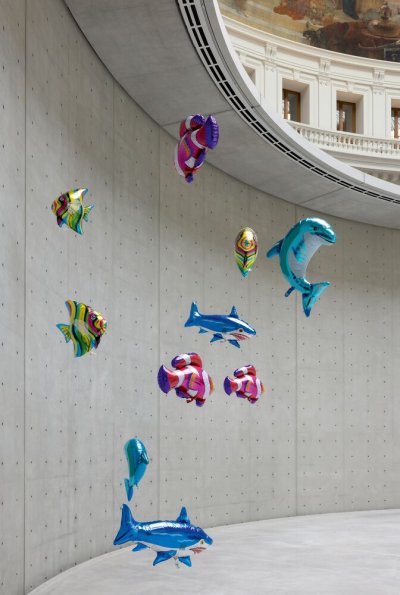Repeating the Obvious
39 digital archival prints.
Dimensions variables.
Repeating the Obvious reproduces in multiple formats a blue monochro-matic print of a young black man wearing a hoodie. As if emerging from the dark background, the figure remains vague, blurred, and impossible to identify. It is only thanks to the lighter tones that his body becomes apparent, almost disembodied, floating.
The image is taken from the series All the Boys, made by Carrie Mae Weems in 2016, at a time when the Black Lives Matter movement was mobilizing in reaction to the numerous murders of African Americans perpetrated by police officers and white civilians. In this context, the repetition of this anonymous figure, whose blurred contours are diluted in the blue background of the painting, seems to embody disappearance, but also the prolif-eration of acts of racist violence.
The different dimensions of the images that punctuate the wall installation give the impression that the body is approaching or moving away from the viewer. The image of the young man, which is repeated until it covers large sections of the wall, appears less as an individual portrait than a generic vision that seeks to embody and subvert the stereotypical iconography of the young African American man, which has been propagated by hegemonic discourses. The serial treatment echoes this generic and dehumanized perception of black men, which tends to homogenize their representation, as if they were a single entity. The media's treatment of the black community reflects this blurred and imprecise portrait, which is more a reflection of the collective unconscious than of a concrete reality. Through it, the artist underlines the recurrence of these gaps that proliferate and keep repeating them-selves, ignoring the diversity and complexity of black experiences.
"Repeating the Obvious would not be primarily a history of white violence, but would become an act of self-empowerment over this history on the basis of a present that has long remained latent in a culture that is self-aware. And this ghost, this spirit, will be what survives from that history. Mourning the one whose life was snatched away by police bullets would then be marked by the permanent presence of a guest who tells us of the possibility that the story of white violence is not the only story to be told, but that there are possible and long-used bifurcations leading out of this history of violence." Repeating the Obvious reproduces in multiple formats a blue monochro-matic print of a young black man wearing a hoodie. As if emerging from the dark background, the figure remains vague, blurred, and impossible to identify. It is only thanks to the lighter tones that his body becomes apparent, almost disembodied, floating.
The image is taken from the series All the Boys, made by Carrie Mae Weems in 2016, at a time when the Black Lives Matter movement was mobilizing in reaction to the numerous murders of African Americans perpetrated by police officers and white civilians. In this context, the repetition of this anonymous figure, whose blurred contours are diluted in the blue background of the painting, seems to embody disappearance, but also the prolif-eration of acts of racist violence.
The different dimensions of the images that punctuate the wall installation give the impression that the body is approaching or moving away from the viewer. The image of the young man, which is repeated until it covers large sections of the wall, appears less as an individual portrait than a generic vision that seeks to embody and subvert the stereotypical iconography of the young African American man, which has been propagated by hegemonic discourses. The serial treatment echoes this generic and dehumanized perception of black men, which tends to homogenize their representation, as if they were a single entity. The media's treatment of the black community reflects this blurred and imprecise portrait, which is more a reflection of the collective unconscious than of a concrete reality. Through it, the artist underlines the recurrence of these gaps that proliferate and keep repeating them-selves, ignoring the diversity and complexity of black experiences.
Repeating the Obvious would not be primarily a history of white violence, but would become an act of self-empowerment over this history on the basis of a present that has long remained latent in a culture that is self-aware. And this ghost, this spirit, will be what survives from that history. Mourning the one whose life was snatched away by police bullets would then be marked by the permanent presence of a guest who tells us of the possibility that the story of white violence is not the only story to be told, but that there are possible and long-used bifurcations leading out of this history of violence.

